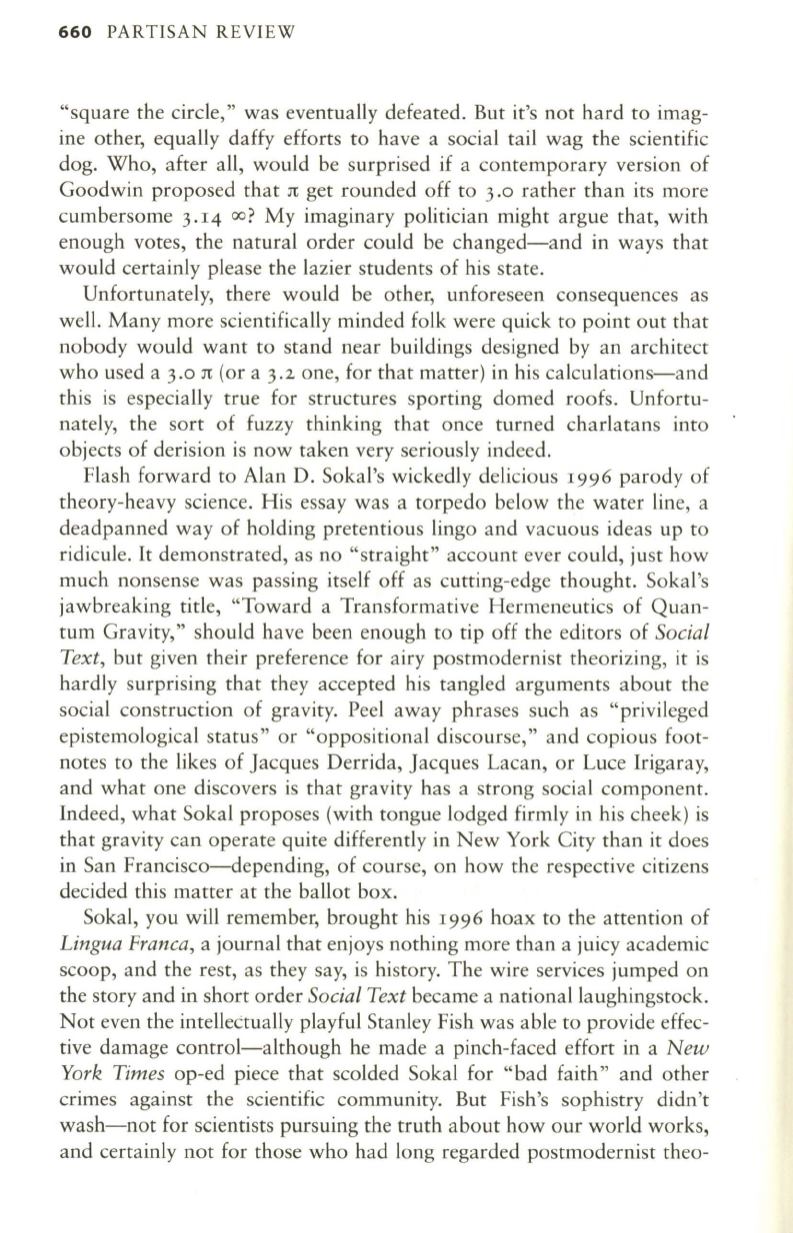
660
PARTISAN REVIEW
"square the circle," was eventually defeated. But it's not hard to imag–
ine other, equally daffy efforts to have a social tail wag the scientific
dog. Who, after all, would be surprised if a contemporary version of
Goodwin proposed that
Jt
get rounded off to
3.0
rather than its more
cumbersome 3.14
oo?
My imaginary politician might argue that, with
enough votes, the natural order could be changed-and in ways that
would certainly please the lazier students of his state.
Unfortunately, there would be other, unforeseen consequences as
well. Many more scientifically minded folk were quick to point out that
nobody would want to stand near buildings designed by an architect
who used a
3.0
Jt
(or a
3.2
one, for that matter) in his calculations-and
this is especially true for structures sporting domed roofs. Unfortu–
nately, the sort of fuzzy thinking that once turned charlatans into
objects of derision is now taken very seriously indeed.
Flash forward to Alan D. Sokal's wickedly delicious
I996
parody of
theory-heavy science. His essay was a torpedo below the water line, a
deadpanned way of holding pretentious lingo and vacuous ideas up to
ridicule.
It
demonstrated, as no "straight" account ever could, just how
much nonsense was passing itself off as cutting-edge thought. Sokal's
jawbreaking title, "Toward a Transformative Hermeneutics of Quan–
tum Gravity," should have been enough to tip off the editors of
Social
Text,
but given their preference for airy postmodernist theorizing, it is
hardly surprising that they accepted his tangled arguments about the
social construction of gravity. Peel away phrases such as "privileged
epistemological status" or "oppositional discourse," and copious foot–
notes to the likes of Jacques Derrida, Jacques Lacan, or Luce Irigaray,
and what one discovers is that gravity has a strong social component.
Indeed, what Sokal proposes (with tongue lodged firmly in his cheek) is
that gravity can operate quite differently in New York City than it does
in San Francisco-depending, of course, on how the respective citizens
decided this matter at the ballot box.
Sokal, you will remember, brought his
I996
hoax to the attention of
Lingua Franca,
a journal that enjoys nothing more than a juicy academic
scoop, and the rest, as they say, is history. The wire services jumped on
the story and in short order
Social Text
became a national laughingstock.
Not even the intelleCtually playful Stanley Fish was able to provide effec–
tive damage control-although he made a pinch-faced effort in a
New
York Times
op-ed piece that scolded Sokal for "bad faith" and other
crimes against the scientific community. But Fish's sophistry didn't
wash-not for scientists pursuing the truth about how our world works,
and certainly not for those who had long regarded postmodernist theo-


